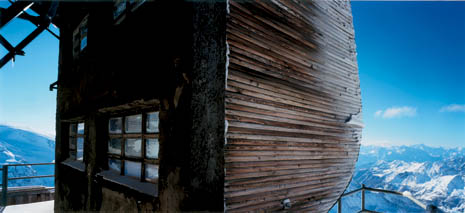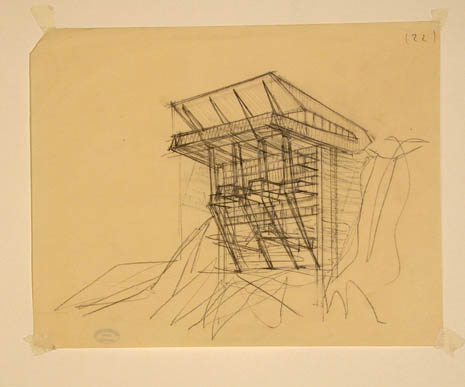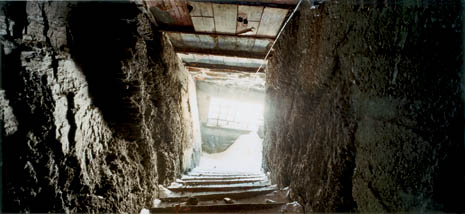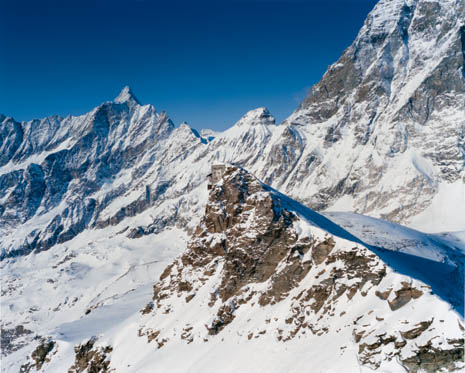 [Image: Carlo Mollino's "architectural solution for extremely high altitudes." Via Domus].
[Image: Carlo Mollino's "architectural solution for extremely high altitudes." Via Domus].Last year, Domus introduced us to an "architectural solution for extremely high altitudes."
But it's not another weird, home oxygen system; it's a derelict ski lift relay station, designed by Carlo Mollino – who apparently once said: "Everything is permissible as long as it is fantastic."
 [Image: Via Domus].
[Image: Via Domus].The ski lift itself was meant to cross upward through the Alpine sky, from mountain top to mountain top, eventually alighting upon the crest of the Matterhorn. As such, it was part of a much larger mountain sports complex – or distributed "micrometropolis," as the article describes it – for prestigious (and wealthy) winter athletes.
Wonderfully, these structures – located on various peaks and connected by cable cars – were partly inspired by "the Tibetan monasteries of Lhasa as self-sufficient and self-justifying mountain units."
Mollino himself wrote, referring to this project: "I believe this construction represents an answer to the question of architecture at very high mountain altitudes, and that it is also a new constructional concept. It is literally anchored in the rock, which had to be dynamited in order to create the albeit partial support platforms. All the rest is cantilevered.”
 [Image: A sketch by Carlo Mollino. Via Domus].
[Image: A sketch by Carlo Mollino. Via Domus].However, "a secret passageway into the glacier" was also constructed; this was a jagged corridor filled with stairways and machinery that Domus refers to as "the famous rock tunnel."
More poetically, they add, it's "a tunnel through the rock of one of Europe’s geological attics."

 [Images: Inside "the famous rock tunnel," that "passageway into the glacier." Via Domus].
[Images: Inside "the famous rock tunnel," that "passageway into the glacier." Via Domus].Though I want so badly to learn that a manmade labyrinth of tunnels and passageways has been blasted through the highest mountains of the Alps – perhaps even possible to ski through – it seems that this "famous rock tunnel" doesn't go very deep, and that it houses nothing but enginery for the ski lift, bobbing noisily in the wind outside.
But there's just something so incredibly evocative about an abandoned network of Alpine ski lifts.
You arrive in a small town in Switzerland, say, having traveled there to research tectonic stress in the rocks of southern Europe – how that continent's ongoing collision with Africa results in magnificent lumps of folded rock, rising miles into the air. Your guidebook mentions a specific geological formation worth the time if you can reach it, because those rocks have neither been seen nor photographed since the early 1950s.
Turns out, the only way up there – and the rocks are way up there: three or four mountains away, in the wind, ice, and weather – is to take a series of abandoned cable cars. No one is even sure how well the machinery works, but, after a few days' tinkering, using a dozen cans of WD-40, you manage to get the thing back on track.
You pack a lunch, put on some gloves, and you bring a new flashlight – and some granola bars, just in case.
And then you ascend, alone, taking photographs, as you pass from one abandoned outpost to the next, gliding through cantilevered architectural structures, each more fantastic than the one before.
By midday, you have arrived at a spectacular cluster of buildings, now abandoned to the snow for over 60 years – but, of course, at that instant, the cable car jams. Gingerly, you step out.
Looking back, you can't even see the village where you started; looking ahead, you can't see the peak you've been looking for. The cables just sort of disappear, sagging and forlorn, covered in icicles, like thin wires between distant cliffsides.
Soon, it's rather late.
 [Image: The Alps. Via Domus].
[Image: The Alps. Via Domus].You crawl into one of the empty buildings in an effort to stay warm – because, outside, the wind has picked up – but you notice that, behind the wood panelling in the back, there's some kind of opening, or even a cave. Or at least there's something: you can't quite tell what it is.
Crawling over to investigate, flashlight in hand, you realize it's not a cave at all, but a manmade tunnel. And it extends downward, at a sharp angle.
Looking closer, you see footprints.
You enter.
No comments:
Post a Comment